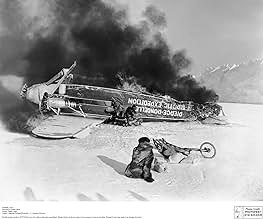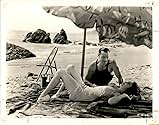VALUTAZIONE IMDb
6,3/10
801
LA TUA VALUTAZIONE
Aggiungi una trama nella tua linguaJack Bradon is tasked to reach the South Pole with a dirigible.Jack Bradon is tasked to reach the South Pole with a dirigible.Jack Bradon is tasked to reach the South Pole with a dirigible.
- Regia
- Sceneggiatura
- Star
- Premi
- 2 vittorie totali
Emmett Corrigan
- Rear Adm. John S. Martin
- (as Emmet Corrigan)
Richard Alexander
- Radio Operator
- (non citato nei titoli originali)
Bess Flowers
- Party Guest
- (non citato nei titoli originali)
George 'Gabby' Hayes
- Parade Official
- (non citato nei titoli originali)
Edward Hearn
- Admiral's Aide
- (non citato nei titoli originali)
Selmer Jackson
- Lt. Rowland
- (non citato nei titoli originali)
Eddie Kane
- Lakehurst Radio Announcer
- (non citato nei titoli originali)
Kenneth MacDonald
- Lt. Fogarty
- (non citato nei titoli originali)
Adrian Morris
- Dirigible 'Los Angeles' Crewman
- (non citato nei titoli originali)
William H. O'Brien
- Sailor
- (non citato nei titoli originali)
Broderick O'Farrell
- Doctor
- (non citato nei titoli originali)
Recensioni in evidenza
While "Dirigible" (1931) is notable as Frank Capra's best early film, the real credit for making something that was both a huge hit during the early years of talking pictures and an old film that will interest even today's jaded action movie fans should go to Editor Maurice Wright. Wright had to assemble this early blockbuster from what Capra shot and what the U.S. Navy provided in the form of stock and promotional footage. He did a great job and you rarely are aware that you watching a movie, let alone a fictional drama.
The story is a historical concoction, mixing elements of Robert Falcon Scott's sledding disaster at the South Pole and Nobile's ill-fated North Pole expedition in the airship "Italia". It is likely the producers of "The Red Tent" (1970) borrowed heavily from Capra's technique when they dramatized the crash of Nobile's dirigible for their film.
The destruction of the fictional dirigible "The Los Angeles" is the most interesting sequence in the film but the Navy's promotional footage is also quite interesting, particularly to viewers 75+ years later. There is extensive coverage of operations on the first USS Lexington; which would be sunk during WWII (The Battle of the Coral Sea). The rest of the simulated action stuff leaves something to be desired but was no doubt quite credible to viewers at the time of the film's release.
I wouldn't pay much attention to complaints that the back-story is lame and boring. It features a pre-Kong Fay Wray. She is younger and has her natural darker hair color. As such, I think you will find her about as beautiful as any actress in film history, especially in profile. Apparently Capra quickly figured out what he had with Wray as he makes extensive use of close-ups during her scenes; a technique that would not really come into fashion until the 1970's. And Wray exhibits considerable acting talent in these scenes, earnestly sincere as the wife of a glory-seeking Navy pilot. And since you can't take your eyes off her, any complaints about scripting and content are pretty much irrelevant.
Then again, what do I know? I'm only a child.
The story is a historical concoction, mixing elements of Robert Falcon Scott's sledding disaster at the South Pole and Nobile's ill-fated North Pole expedition in the airship "Italia". It is likely the producers of "The Red Tent" (1970) borrowed heavily from Capra's technique when they dramatized the crash of Nobile's dirigible for their film.
The destruction of the fictional dirigible "The Los Angeles" is the most interesting sequence in the film but the Navy's promotional footage is also quite interesting, particularly to viewers 75+ years later. There is extensive coverage of operations on the first USS Lexington; which would be sunk during WWII (The Battle of the Coral Sea). The rest of the simulated action stuff leaves something to be desired but was no doubt quite credible to viewers at the time of the film's release.
I wouldn't pay much attention to complaints that the back-story is lame and boring. It features a pre-Kong Fay Wray. She is younger and has her natural darker hair color. As such, I think you will find her about as beautiful as any actress in film history, especially in profile. Apparently Capra quickly figured out what he had with Wray as he makes extensive use of close-ups during her scenes; a technique that would not really come into fashion until the 1970's. And Wray exhibits considerable acting talent in these scenes, earnestly sincere as the wife of a glory-seeking Navy pilot. And since you can't take your eyes off her, any complaints about scripting and content are pretty much irrelevant.
Then again, what do I know? I'm only a child.
The "7" is strictly for the amazing aerial scenes involving airships or dirigibles (like the Hindenberg that crashed at Lakehurst, N.J.). In fact, all of the aviation moments are skillfully photographed for dramatic effect, especially the fierce electrical storm that destroys one of the dirigibles by pulling it apart in mid-flight.
The romance on the ground is far less convincing than the action sequences involving pilots flying to the South Pole. FAY WRAY is the femme lead, hopelessly in love with hubby RALPH GRAVES and begging his best friend JACK HOLT not to use him on his expedition to the South Pole. She's sick of staying behind and worrying about him and his grandstanding exploits. Unfortunately, none of the domestic scenes between Graves and Wray bear any semblance to reality--her weeping gets pretty tiresome before the plot is resolved.
But FAY WRAY was unquestionably a beautiful woman and director Frank Capra gives her plenty of close-ups. Her role is not particularly well written and she has trouble being anything more than a decorative ploy. RALPH GRAVES is not totally convincing as a reckless pilot. There's an awkwardness about his acting that is somewhat disconcerting here. JACK HOLT handles his role with authority and good screen presence.
A fascinating look at early aviation exploits using dirigibles and balloons when they were seriously considered to be the modern methods of aviation. Well worth watching.
The romance on the ground is far less convincing than the action sequences involving pilots flying to the South Pole. FAY WRAY is the femme lead, hopelessly in love with hubby RALPH GRAVES and begging his best friend JACK HOLT not to use him on his expedition to the South Pole. She's sick of staying behind and worrying about him and his grandstanding exploits. Unfortunately, none of the domestic scenes between Graves and Wray bear any semblance to reality--her weeping gets pretty tiresome before the plot is resolved.
But FAY WRAY was unquestionably a beautiful woman and director Frank Capra gives her plenty of close-ups. Her role is not particularly well written and she has trouble being anything more than a decorative ploy. RALPH GRAVES is not totally convincing as a reckless pilot. There's an awkwardness about his acting that is somewhat disconcerting here. JACK HOLT handles his role with authority and good screen presence.
A fascinating look at early aviation exploits using dirigibles and balloons when they were seriously considered to be the modern methods of aviation. Well worth watching.
As we watch the Twentieth Century disappear in our wake, we're going to find films like this more and more precious. I mean, can you imagine? -- Here's a film that takes the airship absolutely seriously as an equal partner with the airplane. Here's a film that shows you basically how an airship was constructed and what it looked like inside, and all that as part of the plot! And if you're going to interrupt the main plot with a soap opera, who better to put in front of your eyes than the beautiful Fay Wray? And what a great way to get out of the romantic sub-plot's basic dilemma -- nice, clean, and fast. All things considered, a more than satisfying way to spend an evening.
I liked this film for it conveys a can-do-attitude that was so prevalent in America at that time. This movie was made (1931) in a time when man was just beginning to test the limits of himself, machine, and the elements (it was only 5 years earlier in 1927 that Limbergh crossed the Atlantic in the Spirit of St. Louis.) This movie focused on the race to the south pole and it made for good entertainment. The special effects for the time were very good.
The human interest aspect of the film showed the negative side of ambition (how it affected a marriage and a friendship)this I found interesting. The character development in the one, Frisky, was especially satisfying.
I would recommend this movie to anyone--however do not compare it to the movies of our time--that would be a disservice to the movie.
The human interest aspect of the film showed the negative side of ambition (how it affected a marriage and a friendship)this I found interesting. The character development in the one, Frisky, was especially satisfying.
I would recommend this movie to anyone--however do not compare it to the movies of our time--that would be a disservice to the movie.
Lakehurst, the setting for much of this film was the epicenter of American ballooning and dirigibles, before the second world war and through it as well. A recent book, _They sailed the skies : U.S. Navy balloons and the airship program_ led me to this film, since it represents an easy way to get a look at some of the men and machines in action. Frank "Spig" Wead is the writer and Frank Capra directs. Wead of course was a flyer himself and only turned to writing after a crash broke his neck, crippling him. See WINGS OF EAGLES by John Ford for a dramatization of his life. The early sound era is not known for the sleekness of it's screen story-telling, but if you have interest in the history of zeppelins, or pre-WW2 aviaton, this film is worth watching.
Lo sapevi?
- QuizThe production was shot during a California heat wave. To form vapor on the breath and give the impression that the pilots were in the Antarctic, the performers were given lumps of 'dry ice' (frozen carbon dioxide) in metal boxes to put in their mouths. Hobart Bosworth found the box cumbersome and simply put the ice in his mouth. He lost his tongue and most of his lower jaw.
- BlooperThe name of this Dirigible was the USS Pensacola but there was already a USN heavy cruiser of the same name that was in service since 1928 when this movie was made. The Navy does not assign duplicate names to ships/air ships in service at the same time.
- ConnessioniFeatured in Frank Capra's American Dream (1997)
- Colonne sonoreAnchors Aweigh
(1906) (uncredited)
Music by Charles A. Zimmerman
Lyrics by Alfred Hart Miles and R. Lovell
Played during the opening credits and often in the score
Sung by guests at a party
I più visti
Accedi per valutare e creare un elenco di titoli salvati per ottenere consigli personalizzati
Dettagli
Botteghino
- Budget
- 1.000.000 USD (previsto)
- Tempo di esecuzione1 ora 40 minuti
- Colore
Contribuisci a questa pagina
Suggerisci una modifica o aggiungi i contenuti mancanti






































